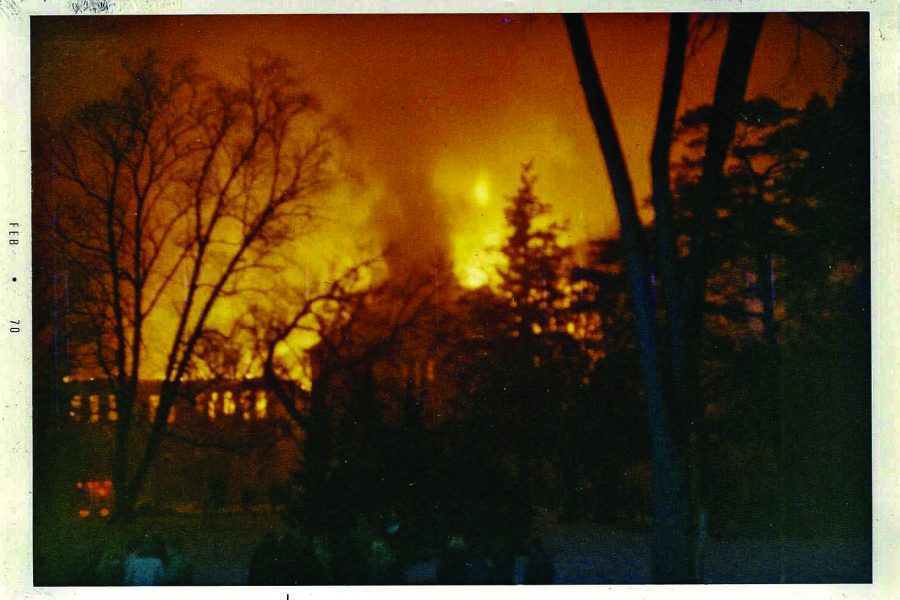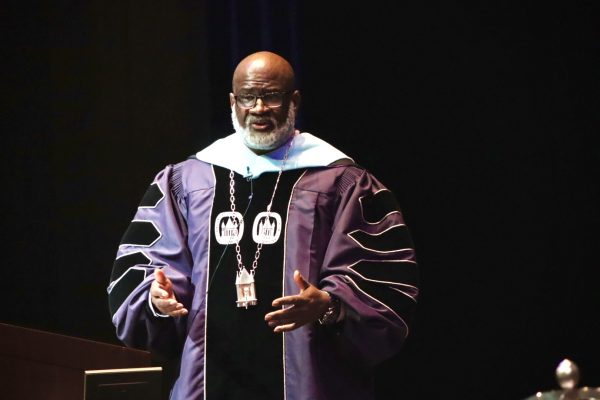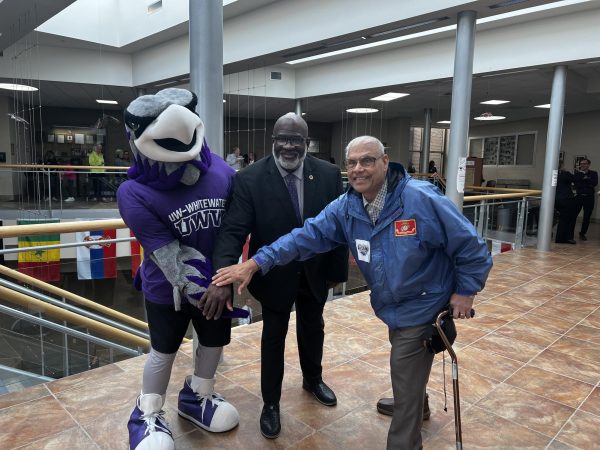The burning history of Old Main Hall
photo courtesy of Nancy and Ron Gumm
Historical photograph depicts the Feb. 7, 1970 fire that destroyed Old Main Hall.
January 20, 2020
Feb. 7, 1970 – The top song was “Venus” by The Shocking Blue, The “Hollywood Palace” aired on ABC for the final time, the United States was entrenched in fighting in the Vietnam War, and racial and political unrest grew rampantly throughout the nation via forms of protests and demonstrations. Some may view the United States, both politically and socially, as utterly chaotic.
As for Whitewater, Wisconsin, this kind of tumultuous atmosphere was commonplace on the campus of then-Wisconsin State University-Whitewater. The actions of a few individuals on that night forever altered the landscape of the university and set off an investigation that has yet to be solved. That incident being the fire that nearly destroyed all of the 102-year old “Old Main” building located in the heart of campus, which now approaches its 50-year anniversary.
What keeps the investigation into the fire unsolved is that no one knows exactly who and what started the fire along with the perpetrator’s motives. This is in part due to the court records being sealed within the Wisconsin Department of Justice. In order to better understand this whole incident, a timeline of events in relation to the fire on Feb. 7, 1970 via documentation provided through the University of Wisconsin-Whitewater Archives and Area Research Center must be presented.
On the night of the fire, three WSU-W students were inside the building during what was reported as the fire’s early stages. Those three students were Keith Masuda, Louis Costanzo and Douglas Stys. Costanzo and Stys, both employees at the university radio station, WSUW-FM, were working their Saturday night shift in Old Main Central. Meanwhile, Masuda was working within the theatre department in the basement of Old Main West.
“As I told the police back then, I entered from the east wing (the Hyer Auditorium side) and walked across the building (the central building). As I walked over in the central wing, I heard footsteps that I just assumed had been the radio station personnel going up to their studio. The next thing I knew was that the police were banging on the window in the west wing because the radio station people knew I was in the basement,” said Masuda in a Dec. 4, 2019 telephone interview. “And pretty much that’s when they told me to get out of the building, so I left out the side door and that was it. The next thing I knew, I stood outside and watched the building start to burn.”
According to a progress report of the grand jury investigation on the fire that was submitted to the Walworth County Circuit Court on Aug. 21, 1970, all doors to the Old Main building were confirmed to have been locked when checked between the time frame of 9 p.m. and 9:15 p.m. This included a ground-level double-set door that led to Old Main West located on Old Main West’s east side underneath a causeway connecting Old Main West and Old Main Central. The report also indicated that approximately 15 minutes later, forced entry was gained through this door via the breaking of the right-side door’s glass portion.
At approximately 9:50 p.m., Stys, who was working alongside Costanzo in the third-floor WSUW-FM office in the northwest portion of Old Main Central, mentioned he overheard the sound of a window breaking in the overpass connecting Old Main Central and Old Main West. The two proceeded to activate the alarm box within the building to alert the police of a potential fire.
According to the progress report of the grand jury investigation, four college-aged students were reported to be within the Old Main building at approximately 10 p.m. Two of the students, most likely Costanzo and Stys, both encountered a person on the third floor of Old Main West. The report described this encounter as follows: “They heard footsteps of a person or persons approaching them from around the corner in a hallway. Just prior to observing said person, one of the students heard a ‘poof’ as though something had just ignited in a somewhat volatile manner. A college-aged male subject then appeared from around the corner. This subject had a can in his hand very similar to a gasoline container. The subject yelled at the two students, ‘Get out, get out of here.’ The suspect then splattered liquid from the can described above over the clothing and body of the two students. During this incident, one of the two students observed a reddish glow reflecting on the wall from the direction from which the male subject had just come.” The report concluded that the two students had encountered one of the arsonists responsible for the Old Main fire.
Meanwhile, three unidentified students reported to the University Center receptionist that a fire may be occurring in Old Main. It was at this moment that police were notified of a potential fire. The police force in tandem with Whitewater police Sergeant Leyland Mules and Officer Michael Fox arrived at Old Main at 10:15 p.m.
According to a Feb. 11, 1970 article from The Whitewater Register, police found the previously mentioned glass portion of the right double-set door which led to Old Main West to be broken. Officer Mules proceeded to the third-floor landing where he encountered a “rolling sheet of solid fire traveling 10 inches above the floor in a straight line from east to west.” He noted that “black specks were on the walls preceding the sheet of fire.”
When Officer Mules traveled to the area underneath the connector to the two wings, he saw a student come around the front of Old Main Central. That student was Louis Costanzo, who warned the officers that Douglas Stys was still in the radio station on Old Main Central’s third floor. When the officers returned with Stys, they noticed smoke coming from the second floor of Old Main West.
The officers along with Stys and Costanzo realized through a light in the basement of Old Main West that Keith Masuda was still working there. The group then proceeded to alert him of the fire and get Masada out of the building.
In addition to Officer Mules’ confirmation of at least one fire seat, officers detected a strong odor as they entered the Old Main building. It was later determined that the odor was from ceramic fluid in the art department located in Old Main West. It is also worth-while to note that the art department contained an abundance of art supplies that are known to be highly flammable such as turpentine and linseed oil.
Referring back to the progress report of the grand jury investigation, testimony was received that a conversation involving three male subjects was overheard near the fire scene at approximately 11 p.m. The three male subjects observed were overheard to state in part, “So he could get a good fire going.” One of the three subjects mentioned above was noted to have been identified, but their name was not included in the progress report.
Regarding the progress report’s description of the efforts by local fire departments to put out the fire, the volunteer fire department from Whitewater attempted to contain the fire found on Old Main West’s third floor to that area by preventing it from crossing the previously mentioned causeway. The volunteers tending to that fire were forced to retreat after encountering the fire set to their rear in the northwest portion of Old Main Central.
A third fire is stated to possibly have been existent in the southeast corner of Old Main North. All of these fires are stated to have been set within a close time frame and were all found to be unconnected.
As the blaze grew and eventually engulfed the heart of the building, fire departments from Fort Atkinson, Jefferson, La Grange and Palmyra were called to assist the Whitewater forces in extinguishing or at least limiting the fire’s damage. The battle with the blaze continued into the early morning hours of Feb. 8, 1970 with an estimated total of 1.6 million gallons of water was used to extinguish the flames.
The initial declaration by multiple authorities on the scene of the fire was that it was an act of arson. This would later become official via a ruling from the Director of the State Fire Marshal’s Office, William Rossiter.
“Our investigation shows that two and possibly three unconnected fires were burning at the same time. It was an incendiary fire. We’ve examined the physical remains and we’ve eliminated all the chances of the fire starting from natural causes,” said Rossiter in the ruling.
In regard to the damage done to the building, the blaze destroyed 28 classrooms throughout the central, north and west wings, and 19 rooms in the east wing due to water damage. Several departments within Old Main saw a total loss of their educational tools and equipment. Around 30 pianos within the music department were lost along with all of the Warhawk Marching Band instruments and uniforms (with the exception of one which is now displayed in the University Center’s “Old Main Lane”). Within the art department, an Art History slide file revered as the best in the entire Wisconsin State University system which contained approximately 35,000 pieces was a complete loss as well as the famous etching press donated by artist Leon Pescheret. Among the biggest losses within the School of Business and Economics was the complete equipment and library of the school. In addition, plans for classroom layout and untold man-hours needed for the construction of the new business building (Carlson Hall, now Laurentide Hall) on Case Street (now William L. Carter Mall) needed to be reworked.
All of the damage caused by the blaze was reported to be approximately $3.3 million.
What remains existent of the Old Main structure today is the East Wing, also known as Hyer Hall. This was due in part by the fire department’s efforts to stop the blaze from damaging that portion of the building, but also via the east wing being the last addition built onto the structure (added in 1925). The east wing was constructed with the most updated emergency technology at the time of its completion, making it the “safest” portion of the building.
As the University of Wisconsin-Whitewater has transformed immensely throughout the past fifty years, the memories and legacy of the Old Main building still resonate across campus and the Whitewater community. Even though so much time has passed since the initial investigation, we still do not know the identity of the perpetrator, their motives, and exactly how they started the fire.























